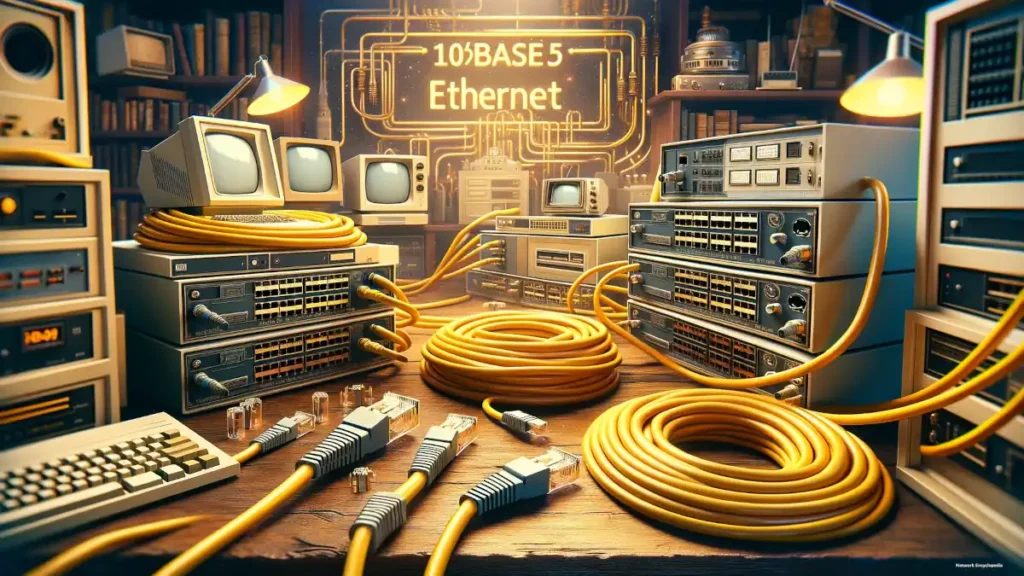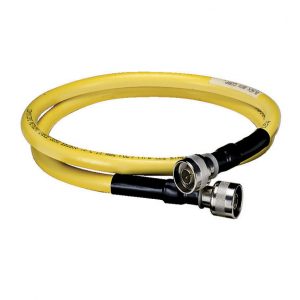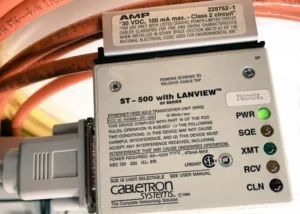In the landscape of computer networking, 10Base5 represents a foundational technology that paved the way for the modern Ethernet networks we rely on today. Known colloquially as “Thicknet,” this early implementation of Ethernet technology utilized thick coaxial cable to connect devices over a network, marking a significant milestone in the development of network infrastructures.
This article delves into the intricacies of 10Base5, exploring its technical specifications, operational mechanics, and the pivotal role it played in the evolution of networking standards. By examining its history and reflecting on its legacy, we aim to provide a comprehensive overview of 10Base5, offering insights into its significance and contributions to the field of computer networking.
Table of Contents:

1. What is 10Base5?
10Base-5 is a type of standard for implementing Ethernet networks. 10Base5 is sometimes referred to as thicknet because it uses thick coaxial cabling for connecting stations to form a network. Another name for 10Base5 is Standard Ethernet because it was the first type of Ethernet to be implemented.

10Base5 supports a maximum bandwidth of 10 Mbps, but in actual networks, the presence of collisions reduces this to more like 4 to 6 Mbps. 10Base5 is based on the 802.3 specifications of Project 802 developed by the Institute of Electrical and Electronic Engineers (IEEE).
2. How 10Base5 work?
10Base5 networks are wired together in a bus topology – that is, in a linear fashion using one long cable. The maximum length of any particular segment of a 10Base5 network is 500 meters, hence the 5 in 10Base5. If distances longer than this are required, two or more segments must be connected using repeaters. Altogether, there can be a total of five segments connected using four repeaters, as long as only three of the segments have stations (computers) attached to them. This is referred to as the 5-4-3 rule.

A 10Base5 segment should have no more than 100 stations wired to it. These stations are not connected directly to the thicknet cable as in 10Base2 networks. Instead, a transceiver is attached to the thicknet cable, usually using a cable-piercing connector called a vampire tap. From the transceiver, a drop cable is attached, which then connects to the network interface card (NIC) in the computer. The minimum distance between transceivers attached to the thicknet cable is 2.5 meters, and the maximum length for a drop cable is 50 meters. Thicknet cable ends have N-series connectors soldered or crimped on them for connecting segments together.
10Base5 networks were often used as backbones for large networks. In a typical configuration, transceivers on the thicknet backbone would attach to repeaters, which would join smaller thinnet segments to the thicknet backbone. In this way, a combination of 10Base5 and 10Base2 standards could support sufficient numbers of stations for a moderately large company.
3. History and Evolution of 10Base5
The Origins of 10Base5 and Its Adoption
10Base5, the original Ethernet standard, emerged from a desire to create a robust, scalable, and efficient method for connecting computers within a local area network (LAN). Developed in the 1970s by Xerox PARC, 10Base5 was officially standardized by the IEEE 802.3 committee in 1983. It was termed “10Base5” to signify a 10 Mbps transmission speed, baseband signaling, and a maximum segment length of 500 meters. Utilizing thick coaxial cable, it was designed to support up to 100 connected devices per segment. The adoption of 10Base5 marked the beginning of networked computing on a scale previously unattainable, allowing for the sharing of resources and data across multiple computers in academic and research institutions, followed by widespread commercial adoption.

The transition from 10Base5 to Modern Ethernet
As technology advanced, the limitations of 10Base5—such as its cumbersome cable installation, maintenance difficulties, and limited data transfer speed—became apparent. The introduction of 10Base2, or “Thinnet,” offered a more flexible and cheaper alternative, though it still operated on coaxial cable. The real transformation came with the advent of twisted pair cabling standards like 10Base-T, which significantly reduced installation complexity and cost while maintaining the same data transfer rate. This evolution continued with the development of faster Ethernet standards, including 100Base-T (Fast Ethernet), 1000Base-T (Gigabit Ethernet), and beyond, facilitating greater speeds and compatibility with new types of media. The transition from 10Base5 to modern Ethernet technologies reflects the continuous quest for more efficient, scalable, and easier-to-manage networking solutions.
Legacy and Impact on Current Technologies
The legacy of 10Base5 is enduring, laying the groundwork for the Ethernet protocol’s dominance in LAN technologies. Its development introduced concepts such as collision detection (CSMA/CD) and network topology that remain foundational to Ethernet. Even as newer technologies have surpassed the original specifications of 10Base5 in speed and ease of use, the core principles of Ethernet have remained consistent. Today’s Ethernet networks, supporting speeds up to 400 Gbps and beyond, still trace their architectural roots back to the original 10Base5 standard. The evolution from 10Base5 to modern Ethernet also exemplifies the importance of adaptability and innovation in technology, ensuring that networking infrastructure can meet the ever-growing demands for data transmission and connectivity in the digital age.
4. References
Books and Academic Papers on Ethernet Technologies
- “Ethernet: The Definitive Guide” by Charles E. Spurgeon and Joann Zimmerman provides an in-depth look at Ethernet technologies, including historical development and technical specifications.
- “Data and Computer Communications” by William Stallings offers comprehensive coverage of networking concepts, including Ethernet standards and their evolution.
- “Computer Networking: A Top-Down Approach, Global Edition” (7th Edition), by James Kurose, Keith Ross (2018)
RFCs and Technical Documents Related to 10Base5
- RFC 1042: This document describes the transmission of IP datagrams over IEEE 802 networks, including 10Base5 Ethernet.
- IEEE 802.3 Standard: The original standard document for 10Base5 Ethernet, detailing the technical specifications and operational parameters.
Further Reading and Resources
- IEEE Explore: A digital library providing access to IEEE journals, conferences, and standards, offering extensive resources on Ethernet and networking technologies.
- The Internet Archive: Offers historical documents and texts related to the development of Ethernet and computer networking.
- “Interconnections: Bridges, Routers, Switches, and Internetworking Protocols” by Radia Perlman: This book delves into the underlying principles of networking, including the role of Ethernet in the broader context of network design and operation.
These references provide a comprehensive foundation for understanding the development, implementation, and enduring impact of 10Base5 Ethernet on modern networking practices.